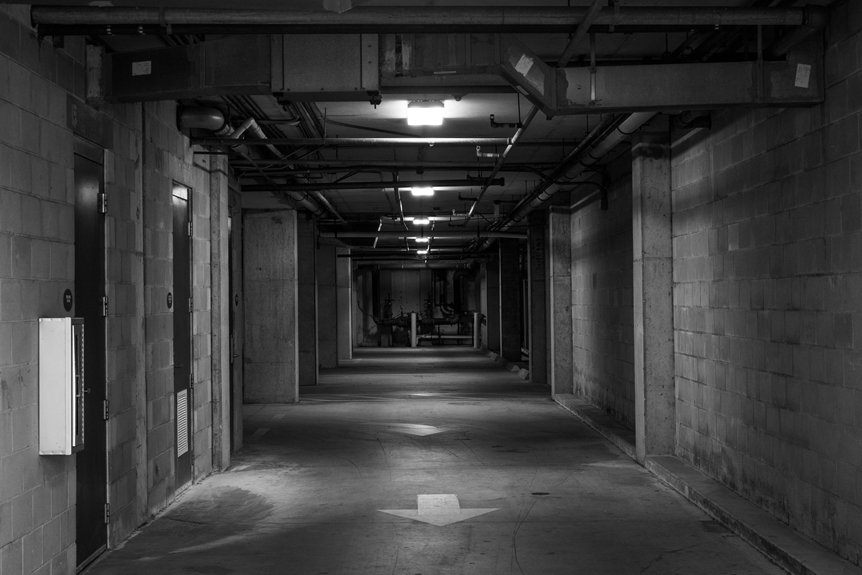Waterproofing old stone basement walls is essential if you want to maintain a dry and healthy living space. Moisture can lead to structural damage and mold growth, so addressing the issue promptly is key. Start by inspecting your walls for any cracks or stains. With the right tools and materials, you can effectively protect your basement. But what steps should you take to guarantee long-lasting results? Let’s explore the process further.
Key Takeaways
- Inspect and repair any visible cracks in stone walls using a concrete patching compound to prevent water infiltration.
- Apply water-resistant sealants to the interior of stone walls for added protection against moisture.
- Utilize a dehumidifier to maintain optimal humidity levels, reducing condensation and mold growth.
- Ensure proper drainage by regularly checking and maintaining gutters and downspouts to direct water away from the foundation.
- Conduct moisture testing using methods like calcium chloride tests or moisture meters to assess wall dampness effectively.
Understanding the Causes of Moisture in Stone Basements
When you’re dealing with moisture in stone basements, understanding the root causes is vital for effective waterproofing.
Common moisture sources include groundwater infiltration, condensation from high humidity levels, and leaks from plumbing. Without proper humidity control, the air in your basement can hold excess moisture, leading to dampness and mold growth.
It’s important to identify these sources early on. Check for cracks in walls, verify proper drainage around your home, and consider using a dehumidifier to maintain ideal humidity levels.
Assessing the Condition of Your Basement Walls
To effectively waterproof your stone basement walls, you first need to assess their current condition.
Start with a visual inspection to identify any cracks or damage, then employ moisture testing methods to gauge humidity levels.
Finally, evaluate the structural integrity to guarantee your walls can withstand any potential water pressure.
Visual Inspection Techniques
Before you plunge into waterproofing your stone basement walls, it’s essential to assess their current condition through effective visual inspection techniques.
Start by examining the walls for cracks, stains, or efflorescence, which may indicate moisture issues. Look for discoloration or peeling paint, signaling potential leaks. Pay attention to the foundation and corners, as these areas are often vulnerable.
Use a flashlight to inspect dark spots where mold could thrive. Document any signs of damage for future reference.
This visual inspection will help you pinpoint problem areas and guide you in your moisture identification efforts before moving forward with waterproofing solutions.
Moisture Testing Methods
Regularly testing for moisture in your stone basement walls is essential to identify hidden problems that visual inspections might miss.
Understanding potential moisture sources and employing effective testing techniques can help you maintain a dry environment. Here are some methods you can use:
- Calcium Chloride Test: Measures moisture vapor emissions.
- Moisture Meter: Provides instant readings of wall moisture levels.
- Infrared Camera: Detects temperature variations indicating moisture presence.
- Dampness Indicators: Simple tools that change color when moisture is present.
- Hydrometer: Assesses humidity levels in the air.
Using these techniques, you can proactively manage your basement’s moisture issues.
Structural Integrity Evaluation
Evaluating the structural integrity of your basement walls is vital for maintaining a safe and functional space.
Start by looking for cracks, bulges, or signs of water damage, as these can indicate serious issues. Assess the foundation stability by checking for uneven floors or doors that stick, which may signify shifting walls.
Use a moisture meter to identify potential areas of weakness in wall integrity. If you notice significant damage, it’s important to consult a professional.
Addressing these concerns early can prevent costly repairs and guarantee your basement remains dry and secure for years to come.
Essential Tools and Materials for Waterproofing
To effectively waterproof your stone basement walls, you’ll need a few essential tools and materials that streamline the process.
Gathering the right items guarantees a successful project and a dry environment. Here’s what you should have on hand:
- Water resistant sealants
- A high-quality paintbrush or roller
- A concrete patching compound
- A sturdy trowel
- Drainage systems components
With these tools and materials, you’re set to tackle the waterproofing effectively.
Each item plays a vital role in sealing and protecting your stone walls, ultimately keeping your basement dry and functional.
Step-by-Step Guide to Waterproofing Stone Walls
Once you’ve gathered your essential tools and materials, you can begin the waterproofing process for your stone basement walls. Follow these steps for effective stone wall treatments:
| Step | Action |
|---|---|
| 1 | Clean the walls with a wire brush. |
| 2 | Repair cracks using a suitable filler. |
| 3 | Apply a waterproofing sealant evenly. |
| 4 | Use a masonry waterproofing paint. |
| 5 | Allow it to cure fully before testing. |
Preventative Measures to Maintain a Dry Basement
After successfully waterproofing your stone basement walls, it’s important to implement preventative measures to maintain a dry environment.
To ensure lasting dryness in your stone basement, prioritize preventative measures after waterproofing.
Here are some effective strategies:
- Regularly check drainage systems for blockages.
- Install a dehumidifier to manage humidity control.
- Guarantee gutters and downspouts direct water away from your foundation.
- Inspect and repair any cracks in walls or floors promptly.
- Keep the area around your home clear of debris to promote drainage.
When to Seek Professional Help for Waterproofing
If you notice signs of severe damage, like cracks or mold growth, it’s time to contemplate professional help for waterproofing your stone basement walls.
Complex issues often require specialized solutions that you mightn’t be equipped to handle alone.
Additionally, if you’re short on time or lack the expertise, hiring a professional can save you both stress and potential costs down the line.
Signs of Severe Damage
Water damage in your stone basement can be a silent menace, often revealing itself through subtle signs that indicate severe issues.
It’s essential to act swiftly if you notice any of the following:
- Visible cracks in the walls
- Persistent wall discoloration
- Musty odors or mold growth
- Water pooling or excessive dampness
- Increased humidity levels
These symptoms warrant a thorough cracks assessment.
If you see any of these signs, don’t hesitate to seek professional help for waterproofing. Ignoring them can lead to more extensive damage and costly repairs down the line.
Stay proactive and protect your basement!
Complex Waterproofing Solutions
While some minor waterproofing tasks can be tackled on your own, complex solutions often require professional expertise.
If your basement has significant moisture issues, consider calling in the pros. They can implement advanced sealing techniques that go beyond basic methods, ensuring a more effective barrier against water intrusion.
Additionally, professionals can design and install tailored drainage solutions to redirect water away from your foundation.
Attempting these complex tasks without the right knowledge can lead to costly mistakes. Trusting experts won’t only save you time but also provide peace of mind, knowing your basement will be properly waterproofed.
Time Constraints and Expertise
When faced with waterproofing challenges and tight schedules, knowing when to call in professionals can make all the difference.
Consider seeking expert help if:
- You lack experience in waterproofing techniques.
- Time management is critical for your project.
- The problem is extensive or complex.
- You need specialized equipment for effective solutions.
- Your skill assessment reveals gaps in knowledge.
Conclusion
By taking proactive steps to waterproof your old stone basement walls, you can effectively prevent moisture and mold issues. Regular inspections, repairs, and the use of quality sealants are vital. Don’t forget to manage humidity levels with a dehumidifier and guarantee proper drainage around your foundation. If you encounter significant damage or feel overwhelmed, don’t hesitate to seek professional help. Keeping your basement dry not only enhances your living space but also protects your home’s overall integrity.

